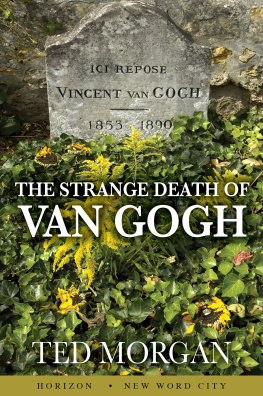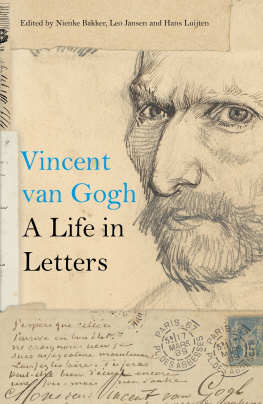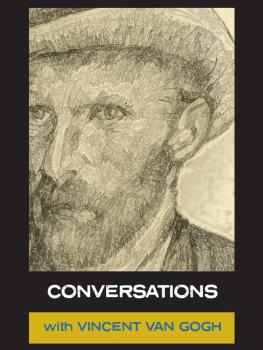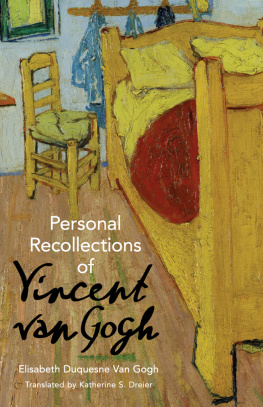Ted Morgan - The Strange Death of Vincent van Gogh
Here you can read online Ted Morgan - The Strange Death of Vincent van Gogh full text of the book (entire story) in english for free. Download pdf and epub, get meaning, cover and reviews about this ebook. year: 2014, publisher: New Word City, genre: Detective and thriller. Description of the work, (preface) as well as reviews are available. Best literature library LitArk.com created for fans of good reading and offers a wide selection of genres:
Romance novel
Science fiction
Adventure
Detective
Science
History
Home and family
Prose
Art
Politics
Computer
Non-fiction
Religion
Business
Children
Humor
Choose a favorite category and find really read worthwhile books. Enjoy immersion in the world of imagination, feel the emotions of the characters or learn something new for yourself, make an fascinating discovery.
- Book:The Strange Death of Vincent van Gogh
- Author:
- Publisher:New Word City
- Genre:
- Year:2014
- Rating:4 / 5
- Favourites:Add to favourites
- Your mark:
- 80
- 1
- 2
- 3
- 4
- 5
The Strange Death of Vincent van Gogh: summary, description and annotation
We offer to read an annotation, description, summary or preface (depends on what the author of the book "The Strange Death of Vincent van Gogh" wrote himself). If you haven't found the necessary information about the book — write in the comments, we will try to find it.
Vincent Van Gogh, perhaps the greatest and most influential painter of the nineteenth century, committed suicide at the age of thirty-seven. He sold only one painting in his lifetime. Was he motivated by mental illness or despair when he put a revolver to his chest or was his physician partly to blame? Here, in this short-form book by award-winning biographer and historian Ted Morgan, is the intriguing answer.
The Strange Death of Vincent van Gogh — read online for free the complete book (whole text) full work
Below is the text of the book, divided by pages. System saving the place of the last page read, allows you to conveniently read the book "The Strange Death of Vincent van Gogh" online for free, without having to search again every time where you left off. Put a bookmark, and you can go to the page where you finished reading at any time.
Font size:
Interval:
Bookmark:
In 1947 , French art critic and playwright Antonin Artaud , whose life had been a struggle between the sometimes conflicting and sometimes allied forces of madness and artistic expression, published a slim volume about a kindred spirit. It was entitled Van Gogh, le suicid de la socit. The tone of the book is one of barely controlled fury, and it seemed to derive from Artauds identification with the dead painter. Both men had suffered from sporadic attacks of mental illness and had been committed to institutions for the insane, Van Gogh voluntarily for about a year, Artaud against his will for nine years. Using Van Goghs case as an example, Artaud announced that doctors were the natural enemies of artists: Artists were subversives who challenged societys established values, while the doctors who treated them were the guardians of those values, their unavowed mission to destroy the artist.
Artauds rambling indictment named the villain in Van Goghs death: the last doctor to treat him, Paul-Ferdinand Gachet , who lived in the village of Auvers-sur-Oise, about twenty miles from Paris. If Van Gogh had not died at thirty-seven, Artaud wrote, I dont need the Grim Reaper to tell me with what supreme masterpieces painting would have been enriched.... Two days before his death, an evil spirit and improvised psychiatrist called Doctor Gachet was the direct, efficient, and sufficient cause of his death.
I have acquired, in reading Van Goghs letters to his brother, the firm and sincere conviction that Dr. Gachet, psychiatrist, in reality hated Van Gogh as a painter, and above all as a genius.
Artaud, more than fifty years removed from the event, had never met Dr. Gachet and did not have a shred of evidence to support his accusation. Dr. Gachet was known to have befriended and helped Van Gogh in the last period of his life, and when Vincent shot himself, it was Dr. Gachet who came to his bedside on a Sunday night and dressed his wound. Nevertheless, Artaud had a manic intuition that Dr. Gachet was somehow the cause of Van Goghs death. Is there any truth to Artauds theory, or can it be dismissed as the distorted view of a man who had himself been mistreated by doctors?
In 1888, Van Gogh was voluntarily committed to an asylum as the result of a violent scene with the painter Paul Gauguin and the partial mutilation of his left ear. His younger brother, Theo , arranged his admission to the sanitarium of Saint-Paul-de-Mausole on the outskirts of Saint-Rmy-de-Provence, an asylum described as a private establishment devoted to the treatment of the insane of both sexes. In his letters to his brother, Vincent described the director, Dr. Peyron, as a gouty little widower who wore dark glasses; the treatment he used was based on hydrotherapy, and Vincent had many sessions in the bathtub during the year he spent in Dr. Peyrons institution.
Vincent started working again at Saint-Paul-de-Mausole. First, he painted what he saw framed in the window of his cell, without the bars. In July, he had a fit, and Dr. Peyron took away his brushes. Vincent asked his brother to tell Dr. Peyron that painting was necessary for him. When he improved, he was allowed to paint in the garden, surrounded by inmates, and in the countryside, accompanied by a guard. The periods of work were interrupted by fits and other forms of erratic behavior. Once, when the guard was walking behind him, Vincent turned around and kicked him in the stomach. Then he apologized, saying he thought the Arles police were after him. Dr. Peyron, in his report on Van Gogh, wrote: He tried on several occasions to poison himself, either by swallowing the oil color he needed for painting or by drinking kerosene which he stole from the boy when he was filling the lamps.
One interpretation of Vincents fits at Saint-Paul-de-Mausole - that they were connected to events in Theos life - was advanced in 1953 by the French psychoanalyst Charles Mauron . Theo, who was working in Paris for the art gallery of Boussod and Valadon, had become engaged to a girl named Johanna Bonger. In the year that Vincent spent confined, Theo married Johanna and had a son by her, whom he named after his brother. Mauron established that the dates of Vincents fits closely followed letters from Theo announcing his marriage and the birth of his son. Maurons explanation was that Vincent, who was dependent on Theo financially, had formulated the following unconscious analysis: Theo is getting married, and it is right that he should devote himself completely to his wife and child. But he is diverting part of his resources from his family to keep me going and part of his affection in his support of me. This is not right, and I must not allow this situation to continue. But how can I change it, except by withdrawing from Theos life, and how can I withdraw except by destroying myself?
Vincent had one crisis in January 1890 and another in February, which lasted two months. He wrote Theo that he could not improve in the asylum, surrounded as he was by madmen. Their madness, he felt, was contagious. He asked Theo to find some other place he might go, and Theo went to the painter Camille Pissarro for advice. Pissarro knew a doctor who specialized in nervous ailments and was friendly with a number of impressionist painters. The doctor, Paul-Ferdinand Gachet, had a house in the pleasant village of Auvers-sur-Oise where he had collected the works of Paul Czanne , Pierre-Auguste Renoir , douard Manet , and other new painters. He himself painted under the pseudonym of Van Ryssel. Just the man, thought Pissarro, who would understand Vincents problems.
Theo wrote Vincent on March 29: I am very happy to be able to tell you that I met Dr. Gachet, that physician Pissarro mentioned to me. He looks like a man of understanding. Physically he resembles you a bit.... When I told him how your crises came about, he told me that he didnt believe it had anything to do with madness and that if it was what he thought, he could guarantee your recovery....
Vincent was delighted at the prospect of leaving the asylum and of being treated by a doctor, who, without even having met him, thought he could cure his condition. He urged Theo to press for his release.
In May, T heo wrote Dr. Gachet: You had given me hope that under your care he might recover his normal state.... I would be most grateful if you could find out about an inn or boardi ng house where he could stay if he came to Auvers.
Vincent left Saint-Paul-de-Mausole on May and went to the nearby town of Tarascon to take the train to Paris. Theo, so concerned about Vincents traveling alone that he had spent a sleepless night, fetched him the next day at the Gare de Lyon and took him home to meet his infant nephew and namesake and his sister-in-law. Johanna, surprised at how healthy and vigorous he looked, thought he was in better condition than Theo.
Vincent wanted to leave for Auvers as soon as possible - Paris made him nervous - and on May 19, with a letter of introduction from Theo, he arrived at Dr. Gachets house, walking up the twenty-two front steps and waiting in a drawing room crowded with paintings, bric-a-brac, and black antique furniture. Dr. Gachet soon appeared, a short man of sixty-two with a long nose, a prominent chin, bright and darting eyes, and stiff red hair that stuck out from his head like the bristles in a hairbrush.
Dr. Gachet told Vincent not to think about his illness, to work quietly, keep regular hours, and eat moderately. He was sanguine about Vincents chances of recovery and prescribed no medication. He sent the patient to a nearby boarding house, but Vincent quickly found a more modest establishment on the Place de la Mairie, Chez Ravoux, where room and board was only three francs fifty a day.
Two days later, Vincent wrote Theo and Jo: I have seen Dr. Gachet, who gives me the impression of being rather eccentric, but his experience as a doctor must keep him balanced enough to combat the nervous trouble from which he certainly seems to be suffering at least as seriously as I. He piloted me to an inn where they ask 6 francs a day. All by myself I found one where I shall pay 3.50 Friday .... The impression I got of him was not unfavorable. When he spoke of Belgium and the days of the old painters, his grief-hardened face grew smiling again, and I really think that I shall go on being friends with hi m and that I shall do his portrait. Then he said I must work boldly on and not think at all of what went wrong with me.
Next pageFont size:
Interval:
Bookmark:
Similar books «The Strange Death of Vincent van Gogh»
Look at similar books to The Strange Death of Vincent van Gogh. We have selected literature similar in name and meaning in the hope of providing readers with more options to find new, interesting, not yet read works.
Discussion, reviews of the book The Strange Death of Vincent van Gogh and just readers' own opinions. Leave your comments, write what you think about the work, its meaning or the main characters. Specify what exactly you liked and what you didn't like, and why you think so.











